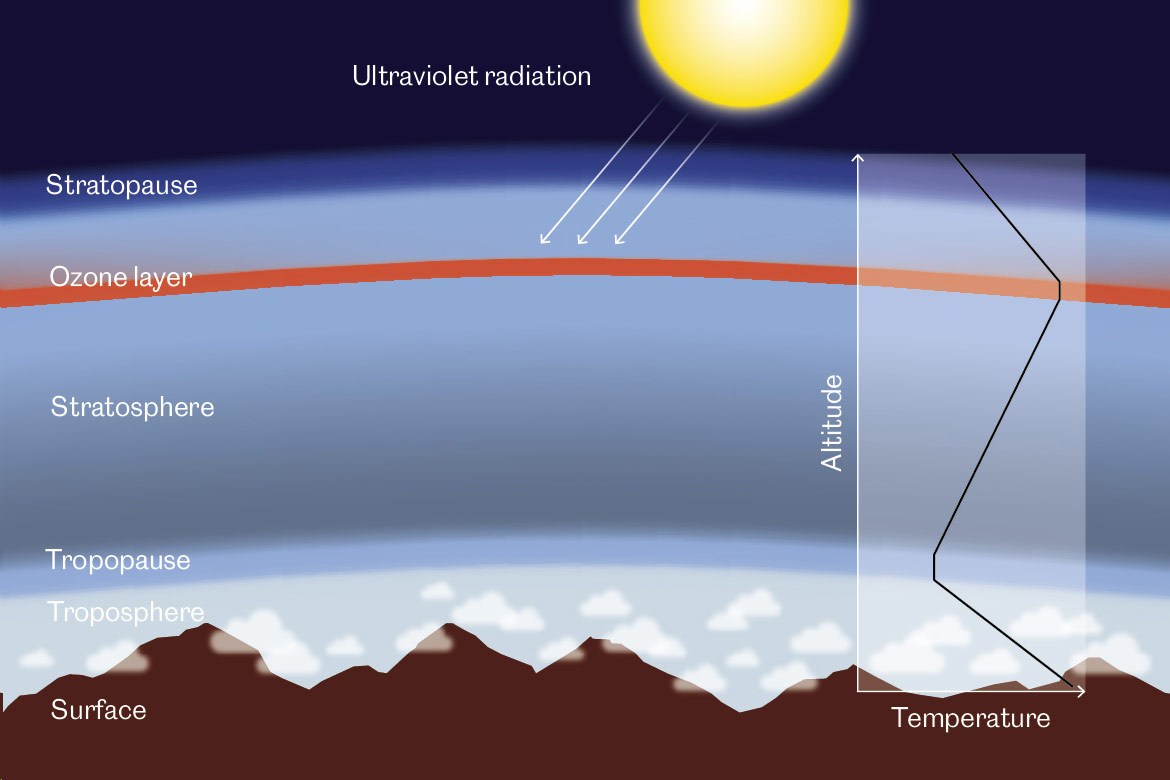Global warming
Hot topic: the ozone layer
The impact of the ozone layer on the climate has been underestimated, particularly in the Northern hemisphere. New studies show that it alters certain weather events.

The concentration of ozone is highest in the ozone layer (orange). It absorbs ultraviolet radiation from the sun, which also influences temperatures on Earth. | Graphic: Bodara
The role of the ozone layer is well known. It absorbs most of the ultraviolet solar radiation that is harmful to organisms and thereby allows life to exist on the Earth’s surface. A team led by Gabriel Chiodo from ETH Zurich has recently shown the ozone layer to possess additional features. Variations in its thickness have a particular effect on the global climate, not without repercussion for the Northern hemisphere.
Ozone is generated in interactions between oxygen and solar radiation in the stratosphere – the part of the atmosphere stretching between the altitudes of 10km to 50 km. In the 1970s the ozone layer saw major shrinkage above the South Pole. This change was found to have been caused by humans and our use of industrial gases like chlorofluorocarbons (CFCs), which used to be found in fridges and spray cans. This depletion has meanwhile been halted, and the UN forecasts that it should have largely recovered in about four decades from now.
Shrinking in the South and the North
The conditions in the Southern hemisphere make it more susceptible to this effect than is the case in the North. Above Antarctica, the temperatures are sufficiently low for stratospheric clouds to form throughout the long polar winter and into springtime. “When the sunlight returns to the stratosphere, it sets off a chemical reaction that degrades the molecules of CFCs containing chlorine on the surface of the clouds. This expels the chlorine atoms into the atmosphere, with destructive consequences for the ozone layer”, says Chiodo. In summer, the conditions change and the deterioration of the ozone layer stops again.
In the North, this effect is much less frequent. But when the temperature of the Arctic stratosphere does fall below its normal range due to weather variations, large polar clouds do form there. They therefore add to the destruction of ozone by CFC in the Northern hemisphere. “And we have good reason to think that this happened in 1997, 2000, 2011 and 2020”, he says.
Chiodo and his team have modelled weather events by integrating the variations in the ozone of the stratosphere. This allowed him to show for the first time the impact on the climate of changes in the thickness of the layer at the North Pole. By absorbing the ultraviolet rays from the sun, the ozone heats up the stratosphere. Consequently, if there’s less ozone, the stratosphere cools. This mechanism then influences winds and weather conditions close to the Earth’s surface.
According to Amy Butler, a researcher at the National Oceanic and Atmospheric Administration of Colorado (USA), taking into account changes in the ozone layer with respect to climate change “might help us to improve our evaluations of how weather conditions react to increases in greenhouse gases”. Generally speaking, it’s not clear if the impact of variations in the ozone layer is good or bad news for the climate. “It’s difficult to predict”, says Chiodo. “For sure, it’s a warning. Until now, we didn’t know that the Northern hemisphere’s climate could also be affected by variations in ozone due to CFC emissions”.
Climate and ozone: a mutual influence
He’s convinced raising awareness is the first step towards change and hopes these results will encourage even more drastic measures to preserve the ozone layer.
He's backed up by Johannes Stähelin, an emeritus professor at the Institute for Atmospheric and Climate Science at ETH Zurich, who adds: “These results show we need to continue to study and to protect the ozone layer. The Montreal Protocol of 1987 to limit CFCs was a good start. But these compounds take many decades to be eliminated from the atmosphere. It’s really necessary therefore that everyone respect the agreement”.




